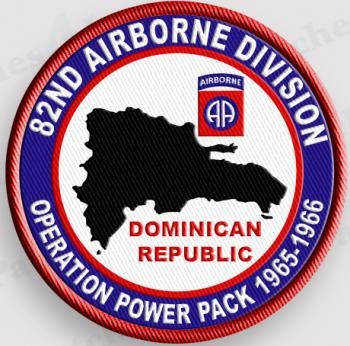As an overseas customer ordering from the UK, I have found www.norbay.com to be very speedy, helpful and professional. Shipping from the USA to the UK has not been a problem and the on-line tracking has allowed me to check the status of my orders. I love the content on the website and they always get new items to look at.
Operation Power Pack
In 1965, during the height of the Cold War, the Americans were concerned about communist influence in the Western hemisphere. This was particularly true with respect to the Caribbean Basin following CubaAca,!a,,cs communist revolution in 1959.
The Dominican Republic shares the Caribbean island of Hispaniola with the nation of Haiti, and was geographically in the center of this area of interest. The Dominican Republic conducted its first free elections in 1962 after the 1961 assassination ended the 30-year domination of strongman and former President Leonidas Trujillo. In the three years after the elections, a constant struggle for political control erupted between communist-sympathizing leftist groups and conservative business and military leaders Aca,!" many with ties to the sugar industry. On April 24, 1965, leftist forces unexpectedly deposed the Dominican leader, Donald Reid y Cabral. Communist-inspired groups of armed civilians, dubbed "Los Tigres," took to the streets throughout the capital of Santo Domingo and quickly overwhelmed the Dominican security forces.
The U.S. Ambassador, W. Tapley Bennett, Jr., described the situation as "collective madness." To authorities in Washington he declared, "I recommend that serious thought be given to armed intervention to restore order beyond a mere protection of lives. If the present loyalist efforts fail, the power will go to groups whose aims are identified with those of the Communist Party. We might have to intervene to prevent another Cuba." President Lyndon B. Johnson, stating the need to protect American lives and property, directed the U.S. military to deploy to the Dominican Republic to stabilize and prevent the country from falling to the communists.
The mission fell to Lt. Gen. Bruce Palmer, the newly-designated commander of the XVIII Airborne Corps, and Maj. Gen. Robert York, commander of the 82nd Airborne Division. They initiated "Operation Power Pack" and ordered a task force comprised of U.S. Marines and the 82nd Airborne to deploy beginning on April 28. The 7th Special Forces Group, Psychological Operations units, and various logistical support elements also participated.
For the Army, this was the first test of the new ROAD Concept (Reorganization Objective Army Division) designed to develop flexible, deployable forces capable of responding to multiple contingencies.
The initial Marine force arrived by helicopter from the USS Boxer and landed on the western edge of Santo Domingo. The 82nd Airborne Division's first elements were air-landed at San Isidro airfield east of the capital. Maj. Gen. YorkAca,!a,,cs plan called for a battalion size element from the 82nd to advance westward and secure the Duarte Bridge connecting the eastern and western sections of the city. They would then be assisted by loyalist elements in regaining control of Santo Domingo.
The 1st Battalion, 508th Infantry advanced to secure the bridge with close air support from Marine F-4 Phantom jets. Securing the area around the bridge was a hazardous undertaking, requiring house-to-house clearing operations while under fire from rebel forces. The effort was further complicated by the fact that the rebels were assisted by Dominican military defectors who wore the same uniforms as loyalist forces allied with the United States. By mid-afternoon on April 30, both the bridge and the cityAca,!a,,cs main power station were secure. By the following morning, the 82nd had advanced further west and linked up with Marine forces. Additional troops worked to permanently secure the east-west transportation route and this Line of Communication (LOC) was dubbed the "All-American Expressway" by the 82nd. To demonstrate that the U.S. military was firmly in control, Maj. Gen. York marched the 82nd Airborne Division band all the way through the corridor.
By the end of the first week, 500 Marines and two full battalions from the 82nd were conducting security operations on the ground, and by the end of May, the entire division was in country. Lt. Gen. Palmer directed subordinate commanders to begin stability operations. Soon the troops were conducting constabulary operations and distributing food, water, and medical supplies to the members of both factions. Ultimately, more than 40,000 U.S. troops participated in Operation Power Pack.
By September 1965, a provisional Dominican government had been set up under the auspices of the Organization of American States. This, in turn, began preparations for elections to reestablish a legitimate government. Most security operations were transferred to a Latin American military task force led by Brazil. One year later, all American forces had left the Dominican Republic.
Operation Power Pack demonstrated the success of the ROAD Concept by proving that the United States military could move rapidly and forcefully to defend its interests in the western hemisphere. Power Pack also served as an important building block for future contingency operations, including Operation Uphold Democracy, the 1994 intervention in Haiti.
We have made a patch to honor these men and women who served in Operation Power Pack.


